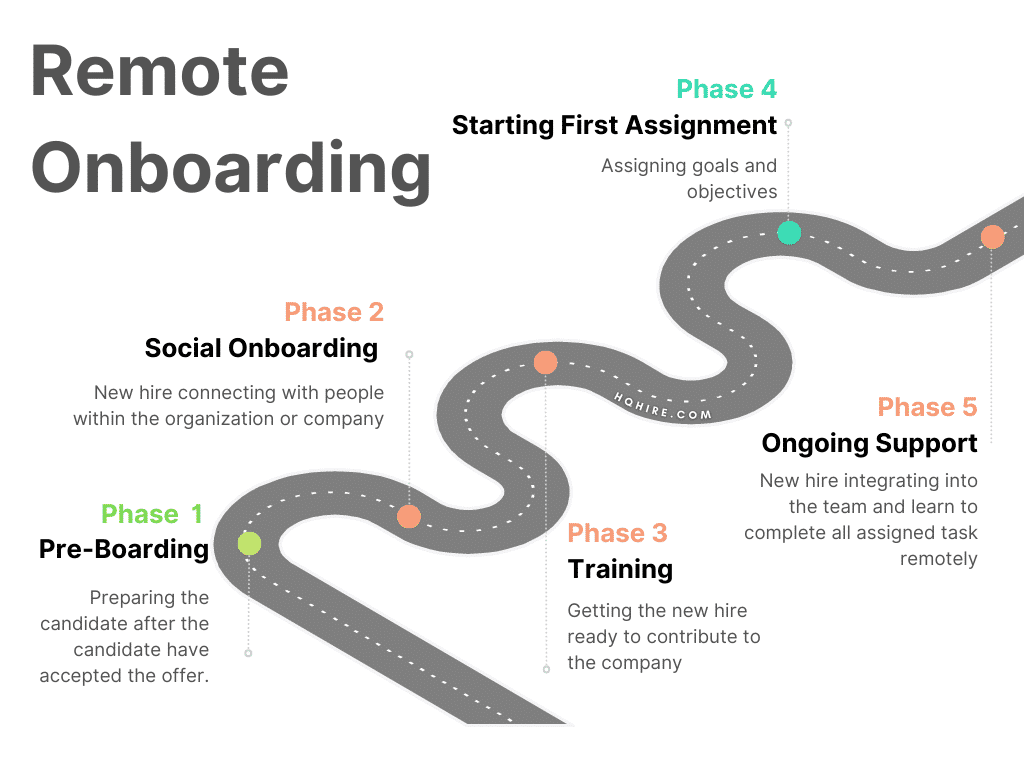Do you feel stressed starting a new job? Confused about the remote onboarding process? Or maybe, this is your first remote onboarding experience?
As more companies are moving to remote work, new employees will likely be having their onboarding remotely.

Starting your new job working from home and getting your welcome and training done from afar can make you feel quite lost.
Going to your new job prepared will help you to build both professional and personal relationships with your manager and coworkers.
One of the best ways is to set up your very own remote ergonomic home office and be prepared for the work challenges ahead.
What to dress during your remote onboarding on your first day of work?
Recommendations: Goals to set at your new job!
How Do You Prepare for Remote Onboarding at New Job?
Remote onboarding is a growing trend in the workplace, and for good reason: it can be more efficient and effective for both the employer and employee.
In fact, generally, a good company with a great remote onboarding process can get you to adapt to your new job within 1 to 3 months.
“Adapt and become comfortable in this remote working environment.”
Here are some tips on how you can prepare for your remote onboarding at your new job!
1. Celebrate your new job
Congratulations! You’ve been starting a new job!
Getting a new job is not always easy, you’ve spent countless hours crafting your resume/ cover letter and sending out countless applications to potential employers.
You may feel anxious about starting a new job, or not knowing how to introduce yourself to your new colleagues.
These feelings are normal, your new colleagues in your new company feel the same when they first started their first day at work.
Instead, you should celebrate your success in landing a new role.
Do not doubt yourself or your capability of performing in your new job.
- Write out a list of your top skills, so you can refer when you are in doubt about yourself.
- Understand your area of strength, so you may know what you can do best.
- Understand your area of growth, so you may know which area to work on to improve your productivity.
“Start a new job with a growth mindset!”
Recommendations: Do you know how to introduce yourself on your first day of work?
2. Set up your remote work office at home
With remote onboarding, your new role will probably allow you to do most of your work remotely in the comfort of your own home.
If you do not have the luxury of having a dedicated room for your home office, you can steal some recommendations below.
Make some simple physical changes to the space where it will become your home office.
- Add a potted plant to your “office table”.
- Change your curtain to simulate the office environment.
- Change the configuration of your furniture.
Make some subtle changes to the workspace:
- Add soft ambiance office sounds or white noise.
- Change the scents of your workspace with the fragrance of essential oil.
“If you work on your couch, your home is your office”.
– A.C. from founder of hqhire.com
Make your “office space” at home different, so you can concentrate better at work, and relax better after work.
3. Start your preparation early
Preparation is always the key to success, this applies to remote onboarding at a new job as well.
“Remote onboarding starts before your first day of work.”
Write an email to HR to confirm your joining date.
Most companies prepare their new employees by sending them information about the company’s culture and project information up to 3 weeks before their first day of work.
Having most of your work activity virtual, there will be a lot of reliance on technology.
Some companies may send you your personnel work laptop to get you started weeks ahead of your first day of work.
Here is some preparation to get you started:
- Watch all videos and information sent by your company.
- Understand your company’s culture and how they work.
- Set up your infrastructure such as the internet to allow you to work from home.
- Find the ideal spot for your “home office” with a good connection to the internet.
- Setup your “workspace”.
- Setup the administration items with your company so you can log into your laptop on your first day of work for the onboarding process.
Start your preparation early, so you may make a great first impression on your first day of remote work!
Recommendations: 7 Best Networking Tips for Introverts
4. Meet your manager “live” and understand the expectation
Understanding expectation from your manager is an important milestone in your remote onboarding process.
With most of your work performed remotely, it is essential to get a clear picture of your duties and responsibilities.
You’ll want to have an in-depth talk with your manager to understand their expectation for you in your new role.
- What does your manager hope to achieve in the next 3 months of your onboarding?
- What does your manager want you to achieve after a year of your being on the job?
- What are your boss’s priorities and how you can help him/her achieve them?
By asking these questions, you will get to understand:
- Organization’s value.
- Team’s objectives.
- Individual goals.
“Show you are willing to do what is required to be done and your passion to grow with the company.”
Establish your own time frames for training, projects, and milestone, and stick to them.
Don’t be afraid to ask for help or request resources.
It is much more acceptable to be asking for guidance during your first 3-month onboarding at your job, than 1 year after that.
5. Get Introduced to Know Your Coworkers and Know Your Work Buddies
Getting started is probably the hardest part of onboarding.
And getting to know new colleagues during your remote onboarding will probably be essential if you want to succeed in your role.
You may consider asking your manager to send out an announcement that you’ve joined the team along with a warm message from you.
- You will love to have a welcome video meeting or phone call to get to know your colleagues better.
- Let your team know what are your contact details, such as phone number, and email.
- A little information about yourself, such as your hobbies and your passion.
Get your organization chart or your team’s work page. Know the faces and names of those whom you will be working with.
They may or may not, reach out to you and say ‘hi’.
But you can certainly reach out to them and make a quick self-introduction and let them get to know you.
If you find someone who is chatty in the call, try chatting with them more and asking them about themselves.
Building rapport with your team virtually means sharing experience and asking questions beyond your job scope.
- What do you like to do during your weekends?
- What are your hobbies?
- What is your favorite book or movie?
If you find a colleague whom you feel comfortable talking to. Invite him/her for a virtual coffee and get to know each other better.
Having a great work buddy will help you integrate better into the team.
Just because you don’t see each other face-to-face, doesn’t mean, you can’t build a great working relationship with your coworkers in a virtual environment.
Recommendations: Work from home SAVES Earth? Work from Home Statistics You should Know!
6. Make Virtual Introductions Yourself
“Hi I am John! I’ve just join the team today, nice to meet you!”
A simple “Hi!” will make all the difference between making a great first impression, or giving the impression of being cold and distant.
This is especially important if you are in a virtual environment where you are physically far away from each other.
Getting to know your team will take more effort as there is basically no small chat at the printer or bonding over a cup of coffee.
Use at least 30 minutes each week to spend some time for pure networking.
- Set up a meeting and get to know each other.
- Set up a group chat so you can talk about stuff other than work.
Do these with people with whom you’ll work directly; your peers, your manager, or those that will be reporting to you.
“Don’t assume your manager or anyone in your team will help you in building your network.”
Take the initiative to talk to your work buddy, your peers, and your boss.
Send introductory emails or plan a virtual happy hour or coffee break to build your network.
Building great relationships early will establish a foundation for long-term success in your career.
Template – Introducing Yourself Virtually with Email
Hi [Name],
My name is [My Name], and I am [Your Role] from [Your Department].
I [Compliment about the recipient].
I am reaching out to you today because [The reason why you are contacting her].
I wish to [Your objective].
Thanks for your time and great to meet you!
Kind Regards,
[Your Name]
[Your Contact Information]
Example – Introducing Yourself Virtually with Email
Hi John Smith,
My name is Jane Pan, and I am a new training coordinator from the Training and Learning Department.
I heard you are amazing in your presentation skills!
I am reaching out to you today because we are thinking of getting a great presenter to help train our new hires on their presentation skills.
I wish to have the honor to invite you to be our trainer and hope we can talk about the details of the training over a cup of virtual coffee soon!
Thanks for your time and great to meet you!
Kind Regards,
Jane Pan
janepan@email.com
(+213) 111 222 33
Training Coordinator
Template – Introducing Yourself Virtually on the Phone
“Hi [Name], I am [My Name], [Your Role] from [Your Department]. Nice to finally talk to you.
I heard that [Compliment about the recipient]. And I am reaching out to you today because [The reason why you are contacting her].
I wish to [Your objective].
When will be the best time for you?
Example – Introducing Yourself Virtually on the Phone
“Hi John, I am Jane Pan, a new training coordinator from the Training and Learning Department. Nice to finally talk to you!
I heard that you are amazing in your presentation skills. And I am reaching out to you today because we are thinking of getting a great presenter to help train our new hires on their presentation skills.
I wish to have the honor to invite you to be our trainer and provide valuable advice to our newcomers.
Hope we can talk about the details of the training over a cup of virtual coffee soon!
When will be the best time for you?“
7. Learn how your team communicates
As we move our work into a virtual environment, learning how to communicate effectively with your team becomes all the more important.
Find out how everyone prefers to communicate.
- Should you email?
- Should you SMS?
- Should you give me a phone call?
- Should you send an instant message using the corporate chat system?
- Should you set up a video conference where you’re able to see each other?
Each team has different work culture and preference in choosing the communication channels.
“We prefer using video conferencing for most of our meetings so that there is more human interaction which allows us to bond more as a team”.
– Janice, editor of hqhire.com
Always keep in mind that communication that is not done face-to-face is often misinterpreted due to the lack of tonality or visual cues.
When an issue arises, offer a phone call or a video conference to sort out the issue immediately.
Relationships are build on great communication and trust.
Getting a sense of how your team communicates will make it much easier for each other to build positive and productive interactions.
Recommendations: 3 Minutes Rule of Productivity
8. Get Feedback
Feedback is the best way to uncover the needs and wants of your manager or your coworkers.
Talk to your manager on a routine basis, and provide feedback on your training, your projects, your progress, and your development.
Talk to your colleagues and understand from them their work and how you play a role in the team’s overall goal.
Make feedback a part of your work culture, as it prevents miscommunication and provides a checkpoint where you can resolve any issues early.
Feedback can be provided in many ways:
- Join “Ask me anything” sessions
- Employee survey
- One-on-one meetings
- Tier meetings
- Performance tracking systems
If your company does not have a feedback system. It will be great if you can initiate the meeting with your manager.
Having feedback can help you to get the right help when needed with your onboarding process.
- How to Introduce Yourself at Work on Your First Day (with Examples)
- How to Evaluate a Remote Job Offer (It’s About YOU)
- How to Evaluate a Freelance Job Offer For Freelancer ($$ Don’t Always Matters)
- How to Evaluate a Startup Job Offer (4 Powerful Steps)
- 20 Best Practices For Onboarding Remote Employees (Why & How)
Join over 11,000+ achievers who are committed to achieving their career goals!

![How to Hold an Effective Team Catch up Meeting [+Examples] 2 How to Hold an Effective Team Catch Up Meeting](https://hqhire.com/wp-content/uploads/2024/04/Face-to-Face-Meeting-7-min.jpg)
![How Write Follow-up Email [8 Email Templates and Examples] 3 How to Write a Follow-up Email](https://hqhire.com/wp-content/uploads/2024/03/Email-Service-Provider-5.jpg)



